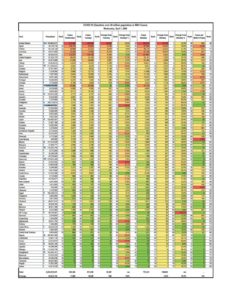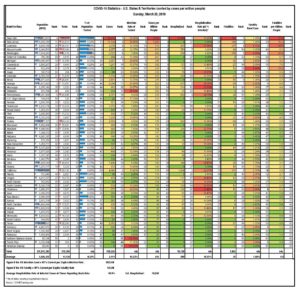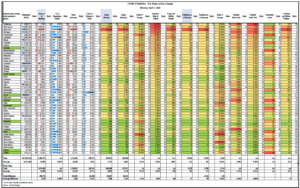HSP compiled the following COVID-19 Statistics for U.S. States and Territories (sorted by cases per million people). This data stands as of Monday, April 6, 2020.
Scroll down to download this excerpt from HSP’s database.
Ok folks, here are the state updates and the news is improving! Of course the increase in death and suffering is terrible no matter what, but the fact that the rate of increase is declining is good! I will be posting a number of “posts” tonight so that each one features its own table, sorted a certain way. The other thing I did was compare the 2-day change between the current 2-day set and the prior 2-day set, and that is where we get mostly good news.
Also, after some discussion with Eryn Ament Bingle about what populations the virus is impacting more/less, it got me thinking about the places and behaviors that would be hotbeds for infection spread. Of course everyone has thought about crowded public transportation (trains/buses) as well as airplanes. However, I have seen very little about casinos. If there every was a place where people touch the same things over and over (bet max!), often do not wash their hands (extremely true for men), have no one cleaning machines more than a few times per day (if that) and where the kinds of people who are there (of all races) are often of lower health quality, a casino is THE super-spreader danger zone. Think of older people who smoke, are overweight, use oxygen tanks and are often in wheelchairs.
I’ve been to and seen enough casinos all over this country to know. It’s a perfect storm for virus (and bacteria) spread. I then wondered how certain states could be doing so well with this virus….populated places. While the correlation to infection and fatality rates is not a perfect correlation, there is certainly a general correlation of lower negative outcomes in states without casinos (UT, HI, AK, TX, GA, VT). Of course many of these states like Texas and Tennessee have casinos on their borders, but you do have to really make an effort to get there in most cases. So, there is my new partial theory of extra infection spread. My thought about Vegas is that most people going to the strip are not local and go home to spread their germs, whereas a place like the casinos in Mass, Connecticut and New Jersey (Atlantic City) are mostly used by people who live in the area, which is a massive hotbed. Detroit (and Windsor, ON) are also big casino hotbeds. So that’s my somewhat-baked thought for the night.
Going forward, I am really hoping that casinos and transportation systems of all kinds employ 5x the cleaning and disinfecting crews that they do now. I think we would all be happy to pay a bit more in our ticket to ensure that the place was constantly wiped down, sprayed and disinfected. We did it with TSA after 9/11, why not now?
Ok, so with this post, I’m attaching the first sorted table: percent of population tested. We now have 7 states that have tested 1.0% or more of their population: NY, LA, WA, MA, VT, UT, and NJ. Most of these are highly impacted states, other than Utah, which is becoming the shining star of this pandemic in the U.S.
We have one outlier at the bottom: Oklahoma. What’s up? I don’t know, but they are by far the least tested state and as a result apparently are only testing those with bad symptoms, as 50% or so of those tested are positive, compared with 19% of the national average.
Interestingly, 2-day testing has increased 18%, which is much lower than the 28% 2-day testing increase of the prior 2-day period. Actual growth in numbers of completed tests is also down slightly, which is surprising. I think we all keep waiting for the big increase. However, any increase provides more clarity.
In terms of states that are finally getting big increases in testing: Mississippi, Michigan and Georgia. YAY for them. MS was way behind before and is now above average (something MS can’t often say in any ranking). Michigan is really feeling it despite the massive increase in tests, as their outcomes are still poor per capita and overall. Maine, California and South Carolina barely budged their testing numbers since Saturday, which is pretty sad. California is actually appearing to do well despite a very low rate of testing and growth in testing. Overall, the US now has 1.9 million completed tests. Average infection rate per test is still 18.9%.



